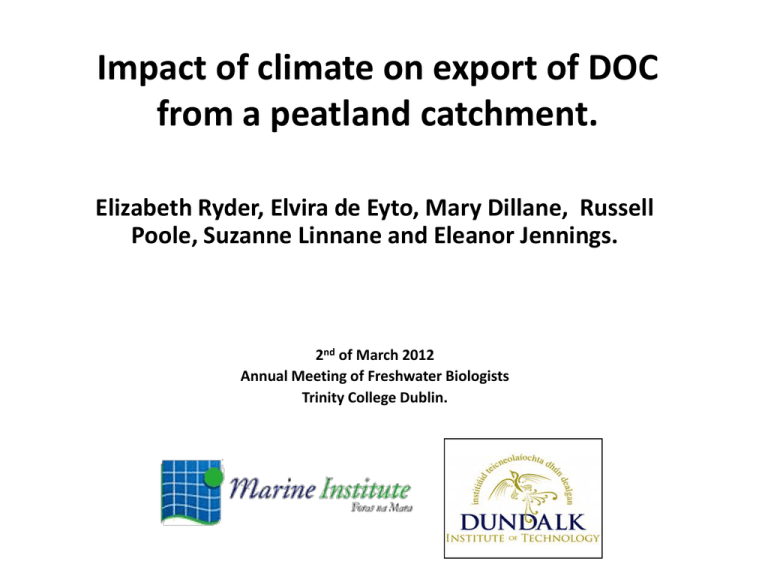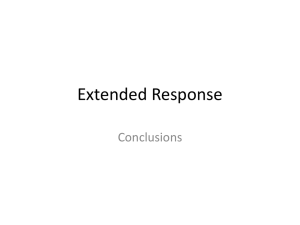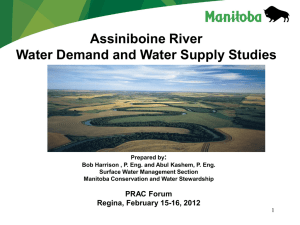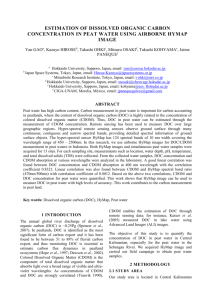Impact of climate on export of DOC from a peatland catchment.
advertisement

Impact of climate on export of DOC from a peatland catchment. Elizabeth Ryder, Elvira de Eyto, Mary Dillane, Russell Poole, Suzanne Linnane and Eleanor Jennings. 2nd of March 2012 Annual Meeting of Freshwater Biologists Trinity College Dublin. Introduction • Sources of carbon • Site Description • Drivers of carbon – Examples. Sources of carbon Two main sources of carbon, specifically dissolved organic carbon (DOC) in aquatic ecosystems 1. Terrestrial (Allochthonous carbon) 2. Primary production (Autochthonous carbon). Sources of carbon Worldwide peatlands cover 500 million hectare of land. Most extensive in Europe and North America. Peatlands or bogs are one of the largest stores of carbon in the world. Organic carbon content (%) in topsoils (0–30cm) in Europe. Peatlands are those with organic content of greater than 25% (Montanarella et al. (2006). Glenamong sub-catchment GG Rain Gauge GG Rain Gauge ARMS (Temperature, Conductivity, pH, DO, CDOM fluorometer, nephelometer) and water level recorder GG Rain Gauge GG Rain Gauge GG Rain Gauge •Catchment Area 1821 ha. •Forested area 408 ha = 22% •Annual rainfall = 2000mm CDOM fluorometer: Chromophoric Dissolved Organic Matter is the light absorbing component of dissolved organic matter. After initial corrections and calibrations 1. CDOM fluorescence (mV) temperature corrected. 2. CDOM fluorescence (mV) was converted into QSU CDOM fluorescence can be used as a proxy for dissolved organic carbon (DOC). Water Colour is also a proxy for DOC. Mean daily DOC export from the GG catchment Annual DOC export 9.87 tC km2 DOC Drivers 1. Temperature 2. Soil moisture (Impact on decomposition processes) 3. Precipitation (variation in timing and intensity) Glenamong DOC export 2010-2011 Temperature •Soil organic matter decomposition in response to temperature •Temperature effect on decomposition rates vary due to different soil moisture content leading to differences in aerobic and anaerobic decomposition Temperature How will global warming affect these carbon pools? 2.0 1.5 1.0 0.5 0.0 -0.5 -1.0 1890 1900 1910 1920 1930 1940 Global anomaly 10 year moving average(Global) 10 year moving average(Ireland) 1950 1960 1970 1980 1990 2000 2010 Furnace anomaly 10 year moving average(Furnace) Air temperature trends globally, in Ireland and in Burrishoole Mean annual air temperature in Burrishoole increased significantly by 1.48 oC Fealy et al. RESCALE project final report 2010 Soil Moisture • Production of DOC have been shown to be correlated with low soil moisture over time. • Decomposition rates of peatlands are very sensitive to changes in soil moisture, particularly in soils that are generally water logged. • Decrease in water table, allowing oxygen into anoxic layers and lead to increase in aerobic decomposition of peat Precipitation Low soil moisture + high precipitation Drought/Precipitation event Drought/Precipitation event Precipitation After the autumn DOC flux, DOC concentrations remain comparatively low irrelevant to storm events Seasonality of DOC export may result in an over estimation of DOC fluxes during winter/spring load estimates. Emission-Excitation Matrix Scans (EEM’s) for Glenamong River. The EEM scan enables a detailed characterisation of the organic matter and can discriminate between humic and fulvic-like acid. Glenamong Janurary 2010 Glenamong June 2010 Glenamong August 2010 Full excitation emission plots Black square = where field instrument measures 370 – 440nm Glenamong September 2010 CDOM Fluorometers, under estimate the carbon exported from the catchment.











